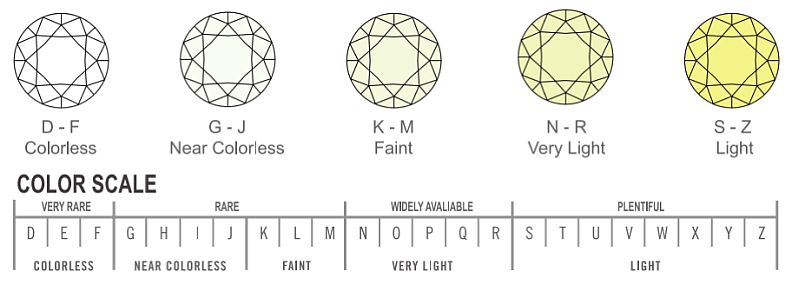There are different colored diamonds, from pink to blue to yellow. Some of these diamond colors can be highly prized, but in a white diamond, a yellow tint will adversely affect the price. This is because the less body color in a white diamond, the more light it will reflect, and the greater its value will be. Diamonds are assigned a color grade by the GIA in a viewing environment specially designed to eliminate color from surrounding surfaces as well as from the light source itself. This allows the diamond color grade to be accurately measured. Different color diamonds are detected in this environment are very difficult if not impossible to detect in a normal environment. The diamond industry has adopted the GIA diamond colors scale; almost every diamond sold today is rated using the GIA color scale, whether it was actually certified by the GIA or not. The GIA grades diamonds on a scale of D (colorless) through Z (light color). All D-Z diamonds are considered white, even though they contain varying degrees of color. True fancy diamond colors (such as yellows, pinks, and blues) are graded on a separate color scale.
GIA DIAMOND COLORS SCALE
- 1. Colorless
- 2. Near Colorless
- 3. Faint Color
- 4. Very Light Color
- 5. Light Color
Color Chart for Diamonds

Color becomes much harder to detect once a stone is set in a ring and placed in an environment that contains color (as opposed to the all white background used in diamond color grading). For instance, an H color diamond may look as colorless as a D when set in a ring under normal lighting conditions, especially if the two are not compared side by side. Another factor that affects a diamond's apparent color is the color of the mounting itself. Yellow gold makes slight amounts of yellow in a diamond less obvious, while white metal mountings make the color in yellow diamonds more apparent. The vast majority of untrained observers (and many gemologists) cannot distinguish a color grade from the one just above or below unless the diamonds are compared side by side in a controlled environment. Color becomes more important as carat weight increases, because color is easier to perceive in a larger diamond, just as a carafe of white wine shows more color than a single glass. Questions about color or other aspects of a diamond? Ask a AGI diamond consultant for answers. A consultant will answer any questions you have, and if you like, search for diamonds on your behalf that match your criteria.
BUYING TIPS
For the best value in what would appear to the naked eye as a colorless diamond, look for G-J diamonds. Because color is easier to detect in larger diamonds, opt for G-H in diamonds over 1 carat, and I-J for those under 1 carat. Once set in a ring, these diamonds will look just like higher color grade diamonds. Instead of investing in higher color, invest in higher cut, the most important factor in a diamond's brilliance. Because diamonds with more facets reflect more light, they tend to hide color better than other shapes. So, consider round, princess or other modified brilliant cuts over step cuts such as emerald or asscher if you are concerned about color. If you are concerned primarily about carat weight, and are on a tight budget, consider a yellow gold setting and a round diamond in the K-L color range. A lower color diamond with a higher cut grade will have more sparkle and visual appeal than a higher color diamond with a lower cut grade. If, while shopping for a diamond, you are ever given a color range (e.g. G-H) as opposed to a specific grade, the diamond is not certified by GIA. The seller is only estimating the diamond's color using GIA terminology.
FLUORESCENCE
Fluorescence refers to a diamond's tendency to emit a soft colored glow when subjected to ultraviolet light (such as a "black light"). Roughly 30% of diamonds fluoresce to some degree. Colorless (D-F) fluorescent diamonds sell at up to a 15% discount since the fluorescence is perceived as a defect. In fact, the visible effects of Faint to Medium fluorescence are perceptible only to a gemologist using a special UV light source.Because the fluorescent glow is usually blue (which is the complementary color to yellow) fluorescence can make diamonds of I-M color appear up to one grade whiter. For this reason, I-M diamonds tend to sell at a slight premium when they possess Medium to Very Strong fluorescence.Overall, diamond fluorescence should not be a major factor in the purchase of a diamond since its effects are negligible, if not slightly positive. The exception would be to exercise caution in purchasing a diamond with Strong fluorescence in D-F color diamonds or Very Strong fluorescence in G-H color diamonds(which do not possess enough body color to offset the degree of fluorescence). For a precise summary of the effects of fluorescence on price, use the chart below. The effect on price varies depending on the degree of fluorescence, diamond color, and clarity. For example, according to the chart, an E color diamond of VS1 clarity and Strong Fluorescence will tend to sell for 3-5% less than a like diamond with no fluorescence. Alternatively, a J color diamond of any clarity and Medium fluorescence will typically sell for up to 2% more than a like diamond with no fluorescence. While clarity has no bearing on the appearance of color and fluorescence, it does impact price. This is because customers who gravitate towards higher clarity tend to be more adverse to the presence of fluorescence.


